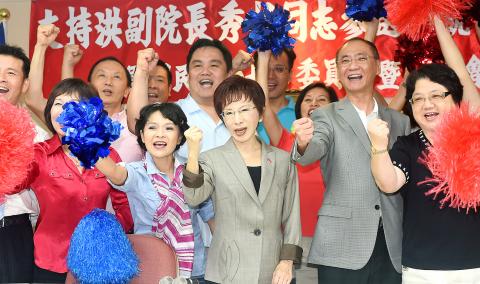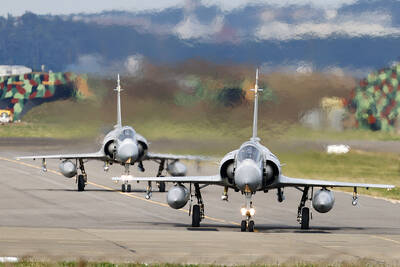Chinese Nationalist Party (KMT) presidential hopeful Hung Hsiu-chu (洪秀柱), if elected, would base her policy on her “one China, same interpretation” proposal, despite it being left out of the party’s newly drafted policy platform, Hung’s spokesman Philip Yang (楊永明) said yesterday.
Yang made the remarks in response to media queries regarding the omission of Hung’s proposal from the policy platform, which is pending approval from the KMT national congress on July 19.
Hung will show nothing but respect for the party’s campaign platform, which is predominantly focused on the KMT administration’s current policy, but “as a presidential hopeful, she has to set out her policy proposals for the future,” Yang said.

Photo: Liao Chen-huei, Taipei Times
If Hung is elected, she would implement policy in accordance with the “one China, same interpretation” formula, Yang said.
The “one China, same interpretation” proposal was described by Hung as an “advanced version” of the so-called “1992 consensus,” backed by President Ma Ying-jeou (馬英九).
According to Hung’s interpretation, “one China” would be the Republic of China (ROC), not the People’s Republic of China.
The “1992 consensus” refers to a supposed understanding reached during cross-strait talks that both Taiwan and China acknowledge that there is “one China,” with each side having its own interpretation of what “China” means.
Although Hung has praised the apparent cross-strait rapprochement that has taken place under Ma’s administration — which she attributes to his adherence to the “1992 consensus” — she questions whether Beijing has ever recognized the existence of the ROC.
She has said that her formula would make China “accept the fact that the ROC exists.”
Hung’s formula, which has raised concerns that she plans to forge ahead with unification with China, was not incorporated in the proposed revisions to the KMT’s policy platform drawn up earlier this week.
Hung’s proposal of a cross-strait peace treaty contingent on five principles, including compliance with the ROC Constitution, was also omitted from the draft version.
The KMT has written into the draft policy platform the “1992 consensus,” which includes a pledge to “consolidate the 1992 consensus.”
UK Representative to Taiwan Chris Wood yesterday visited Hung at her office at the Legislative Yuan to discuss a wide range of issues related to cross-strait relations, the economy, energy and young people, Yang told reporters following the 40-minute meeting.
Wood was concerned about Hung’s stance on cross-strait relations and Hung explained her position to him, including the need for both sides of the Taiwan Strait to step into “deeper water” to address “political factors” standing in the way of Taiwan’s participation in regional affairs, Yang said.
Yang said Wood extended his congratulations to Hung because she expected to be nominated by the KMT as its presidential candidate next month.
As Taiwan is likely to have a female president next year, assuming Hung runs against Democratic Progressive Party (DPP) presidential candidate Tsai Ing-wen (蔡英文), Wood said the race would have a positive effect on Taiwan, according to Yang.
Wood did not answer questions from reporters regarding the meeting.
Separately, on the question of whether Hung would visit Washington before the election to share her views on cross-strait relations, Yang said that discussions on the matter were ongoing.
“We are assessing all possibilities,” he said.
“[A US trip] could take place before the election or after the election,” Yang said.
Hung has given various reasons for not embarking on a trip to the US, another notable example of her striking a discordant note with the KMT.

Taiwan is gearing up to celebrate the New Year at events across the country, headlined by the annual countdown and Taipei 101 fireworks display at midnight. Many of the events are to be livesteamed online. See below for lineups and links: Taipei Taipei’s New Year’s Party 2026 is to begin at 7pm and run until 1am, with the theme “Sailing to the Future.” South Korean girl group KARA is headlining the concert at Taipei City Hall Plaza, with additional performances by Amber An (安心亞), Nick Chou (周湯豪), hip-hop trio Nine One One (玖壹壹), Bii (畢書盡), girl group Genblue (幻藍小熊) and more. The festivities are to

Auckland rang in 2026 with a downtown fireworks display launched from New Zealand’s tallest structure, Sky Tower, making it the first major city to greet the new year at a celebration dampened by rain, while crowds in Taipei braved the elements to watch Taipei 101’s display. South Pacific countries are the first to bid farewell to 2025. Clocks struck midnight in Auckland, with a population of 1.7 million, 18 hours before the famous ball was to drop in New York’s Times Square. The five-minute display involved 3,500 fireworks launched from the 240m Sky Tower. Smaller community events were canceled across New Zealand’s

‘IRRESPONSIBLE’: Beijing’s constant disruption of the ‘status quo’ in the Taiwan Strait has damaged peace, stability and security in the Indo-Pacific region, MOFA said The Presidential Office yesterday condemned China’s launch of another military drill around Taiwan, saying such actions are a “unilateral provocation” that destabilizes regional peace and stability. China should immediately stop the irresponsible and provocative actions, Presidential Office spokeswoman Karen Kuo (郭雅慧) said, after the Chinese People’s Liberation Army (PLA) yesterday announced the start of a new round of joint exercises around Taiwan by the army, navy and air force, which it said were approaching “from different directions.” Code-named “Justice Mission 2025,” the exercises would be conducted in the Taiwan Strait and in areas north, southwest, southeast and east of Taiwan

UNDER WAY: The contract for advanced sensor systems would be fulfilled in Florida, and is expected to be completed by June 2031, the Pentagon said Lockheed Martin has been given a contract involving foreign military sales to Taiwan to meet what Washington calls “an urgent operational need” of Taiwan’s air force, the Pentagon said on Wednesday. The contract has a ceiling value of US$328.5 million, with US$157.3 million in foreign military sales funds obligated at the time of award, the Pentagon said in a statement. “This contract provides for the procurement and delivery of 55 Infrared Search and Track Legion Enhanced Sensor Pods, processors, pod containers and processor containers required to meet the urgent operational need of the Taiwan air force,” it said. The contract’s work would be